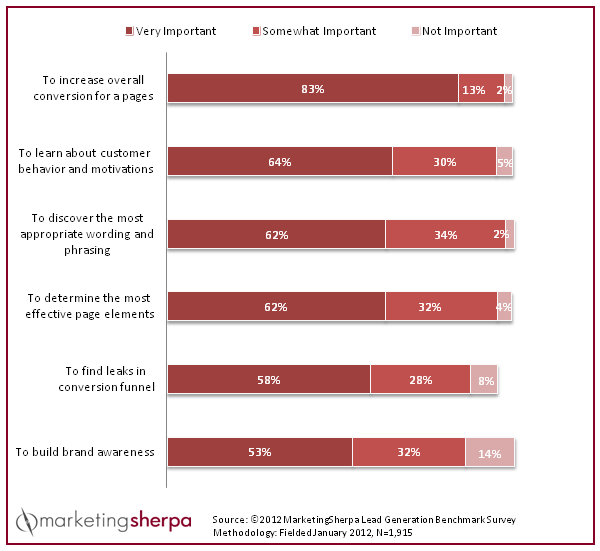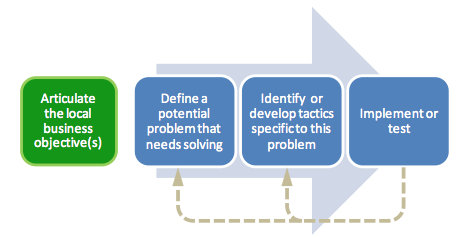Conversion Conversations

As an ecommerce marketer, your number one priority should always be to maximize the conversion rates of your online store. That means you need to focus on your online conversion optimization. This is the final step in your sales funnel, and in many ways, the most important. Too many times misguided marketing “experts” will put too much effort into generating traffic for a site, and not taking the time to convert it once it's there. Traffic is important, but if you’re not making money off of a high volume of it, then that’s a resource wasted. Today’s post will cover the most common and effective methods of converting your traffic into finalized sales.
SEO vs. Conversion Optimization
Generating traffic generally receives more attention than improving conversion rates for a few reasons. It’s flashier, it’s harder to do, and it’s the first step in the process. The first step is usually the most difficult to take, and requires the most energy to gather momentum. Converting traffic into sales isn’t as glamorous as increasing your overall reach, but it is far more necessary, and much more profitable.
Not that SEO itself isn’t an extremely important part of the ecommerce process, but it does end up getting a disproportionate amount of coverage because of its complex and mysterious nature. The end of the argument however goes to conversions for the simple reason of a higher ROI, or Return On Investment.
The ways that search engines work change often and rapidly. That means SEO techniques have to move along with them quickly. That also means that the home page you spent thousands of dollars optimizing so you could be on the front page of Google’s search results has to be maintained to keep that position. This is a constant cost and one that you’ll have to revisit throughout your ecommerce career. However, being on the front page of Google doesn’t necessarily guarantee you any incoming income. Getting the traffic is only half the battle.
That’s where optimizing your landing pages for conversions comes in. And the best thing about it is it’s a single event. You only have to optimize for conversion ONCE. If you’ve designed a landing page that sells, chances are it’s always going to sell, without the need for many changes or updates.
Sure, you might feel the need to reassess your look and see if you can improve your copy from time to time, but by and large if you’ve found a successful formula, you’ll keep using it.
That’s where optimizing your landing pages for conversions comes in. And the best thing about it is it’s a single event. You only have to optimize for conversion ONCE. If you’ve designed a landing page that sells, chances are it’s always going to sell, without the need for many changes or updates.
Sure, you might feel the need to reassess your look and see if you can improve your copy from time to time, but by and large if you’ve found a successful formula, you’ll keep using it.
In other words, your traffic optimization cost will remain somewhat constant, especially if you’re investing heavily in PPC advertising. Your conversion optimization cost, on the other hand, will be a single payment that continues to give you increased profits long after you’ve made the investment.
How to Optimize Conversion Rates: Science and Art

Conversion optimization has often been described as both science and art. Science because there are some specific formulaic processes to follow that have historically and statistically been very successful in creating conversions. It’s also considered art, because there is a great deal of creativity involved in convincing people to part with their money. The art exists mainly in the created content; the science dwells in the extensive testing and format of a successful landing page.
So what are the steps in the scientific part of this process? Well like any good experiment, yours will begin with a hypothesis. You’ll need to come up with a stated purpose for your test. In this case, you’ll be working toward an X% increase in the conversions on your landing page.
You’ve got your goal, now you’ll be making an informed guess, (based on market research using analytic metrics as well as customer feed back) as to what factors you can manipulate on the page to achieve your aims. Based on this assumption, you’ll develop a few different variants of your homepage, each altered in some specified way according to the factors you’ve decided to manipulate, and then you’ll record each page’s results.
You’ve got your goal, now you’ll be making an informed guess, (based on market research using analytic metrics as well as customer feed back) as to what factors you can manipulate on the page to achieve your aims. Based on this assumption, you’ll develop a few different variants of your homepage, each altered in some specified way according to the factors you’ve decided to manipulate, and then you’ll record each page’s results.

When running multivariate tests, you want to make certain that your results are comprehensive enough to gather valid results. That means leaving the testing phase in place for at least one solid week, preferably two. You also want to make sure that you have no less than one hundred unique visitors to each page variant before examining the final results.
Landing Page Design
There are also certain rules you need to follow when building a high converting landing page: Simplicity, visibility, and visual appeal. You’ll need to make your call to action simple. An oft-used tactic is to put a short bulleted list in front of the CTA to remind your customers of the most attractive benefits and features of your product. Directly after the small but persuasive list, you insert an uncomplicated yet compelling call to action.
Visibility means the customer should know where to click at a look. Your page should be organized, not too busy, and easily assessable the first time anyone looks at it. If they have to search where to click in order to place an order, you’ll lose quite a few conversions along the way.
Visual appeal is as simple as it sounds. This ties in with the other two, for the reason that simple visibility is already visually appealing. But still, don’t skimp on the landing page’s design. Make it look bold, professional, and colorful without appearing convoluted, confusing, or complicated
The art applies to the different variants. There is literally no limit to the different types of landing pages you can make. However, you’ll want to make each variant in a single test very similar in order to separate individual factors on the landing page. This way you can test their effectiveness in isolation. Making vastly different variants will give you an idea of which style is more preferred by you customers, but you won’t know what exactly makes it that way.
The final steps in your scientific method will be to gather feedback from your conversions, and add an additional offer. People are naturally excited after a purchase. They’ve just used their hard earned resources to buy something they want that’s just for them. The human body has built in reward systems to incentivize this behavior. After your customer has made their purchase, you need to take full advantage of their lingering excitement and endorphin rush by doing at least one of the following:
- Suggesting similar products or services.
- Offering the customer a chance to describe their experience: what they liked, what they didn’t like. Anything that will give you a better idea of how to set up the bottom of your sales funnel.
- Asking for an email subscriptions.
- Promoting your social media pages.
- Give them something for free: (ebook, newsletter, tutorial video, etc. As long as it’s quality content you build your own value in the customer’s eyes.)
Finally, you need to record your results and develop case studies so that you can compare future online conversion optimization efforts. These case studies will become golden insights for your business plan as time goes on. The more data you have to work with the less you’ll have to rely on intuition, and when trying to make money, it’s always better to rely on data.
If you follow these simple steps, you’re sure to glean insights on how to best set up your landing page to bring in the maximum number of online conversions.














Comment(s)0